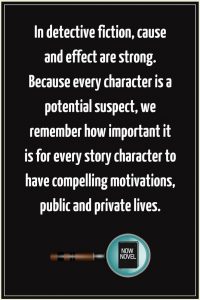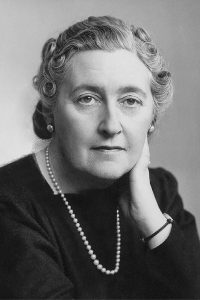The crime subgenre of detective fiction has many aspects that are key to a good story. Cause and effect are strong. Because every character is a potential suspect, we remember how important it is for every story character to have compelling motivations, public and private lives. Here are 7 keys to writing an effective detective novel or short story:
1: Draw inspiration from the great detective authors
Edgar Allan Poe was one of the first great detective fiction writers in the English language. Poe published his story ‘The Murders in the Rue Morgue’ in 1841, featuring the detective C. Auguste Dupin. Poe’s detective fiction is useful to read because it gives useful insights into the genre (You can read Poe’s famous detective story here).
Get clues on how to write detective story protagonists from great detective fiction authors’ work. For example, in ‘The Murders in the Rue Morgue,’ Poe’s detective describes the makings of a great investigator:
‘The Parisian police, so much extolled for acumen, are cunning, but no more. There is no method in their proceedings, beyond the method of the moment … The results attained by them are not unfrequently surprising, but for the most part, are brought about by simple diligence and activity. When these qualities are unavailing, their schemes fail.
‘Vidocq, for example, was a good guesser, and the persevering man. But, without educated thought, he erred continually by the very intensity of his investigations. He impaired his vision by holding the object too close. He might see, perhaps, one or two points with unusual clearness, but in so doing he, necessarily, lost sight of the matter as a whole.’
Poe here contrasts the insightful detective (who can see the parts as well as the whole) with the police force. Unlike the master detective (for Poe’s character), they lack the detective’s heightened ability to deduce answers by examining the parts and the whole of a problem.
Through Poe’s characters’ words, we form a better idea of how to create detectives who are a cut above. Besides reading the masters for clues on how to write a detective story, learn the basic ingredients of detective fiction:
2: Learn effective elements of detective fiction plots
Detective fiction, itself a subgenre of crime and mystery fiction, has subgenres of its own:
In a ‘whodunnit’ or ‘whodunit’, the reader shares the detective’s work. The reader also attempts to deduce who perpetrated a crime based on clues the author weaves into the story. In an inverted detective story, readers might witness the criminal act at the start and also learn the identity of the perpetrator. The rest of the story is then built around the process of the detective uncovering this information.
There are other subgenres too. Police procedurals show policemen tackling and solving crimes. The Dexter book series and TV adaptation is an example of this type of detective story.
Each of these subgenres may have some of the following common detective fiction elements:
- Red herrings: Suspects, clues or turns of events the author creates suspicion around that turn out to be distractions from the truth. These keep the suspense high and make detective story resolutions more unpredictable.
- Detective inquiries: The detective protagonist (or duo or team) makes the rounds, inquiring after leads. Inquiries present the opportunity to create further subplots and complications for the primary investigator(s)
- False suspects: Sometimes the police bring in the wrong suspect. This is similar to a red herring, but false suspects are usually more closely related to the crime.
- Surprise plot twists: There are major unexpected story turns that take the reader by surprise
These are just some of the core ingredients of effective detective plots.
3: How to write a detective story: Master the use of red herrings
Because detective work relies on reason and deduction, a story is most believable when you include misleading information. Even the best detectives can follow false lines of reasoning if all the evidence seems to support this track.
Sir Arthur Conan Doyle’s novel The Final Problem provides a good example of expert red herring use. The detective Sherlock Holmes goes out walking with his sidekick Dr. Watson. Watson rushes back back to their hotel when he receives a message saying a woman urgently needs his medical attention. The message turns out to be a ploy by the villain. He sends this false information to get Holmes alone so that he can attack him. In this case, the red herring is not directly related to the commission of a crime.
Like Conan Doyle, create red herrings to create circumstances necessary for pivotal scenes to take place. In addition to creating a desirable story situation (e.g. ‘The hero is alone and vulnerable to attack’), a red herring brings surprise, keeping the reader guessing. The element of surprise keeps the story fresh and interesting.
4: Give characters interesting motivations
It’s always worth remembering Kurt Vonnegut’s writing advice: Every character in your story should want something. This advice is particularly important when you’re learning how to write a detective story.
Give each character in your detective story a good motivation. An example: The mysterious woman who tries to avoid your detective’s inquiries may be protecting another suspect. This other suspect isn’t the true perpetrator but has an incriminating alibi. Because she’s protecting him, she herself becomes a suspect.
As you plan what actions each character will take in the course of your story, note down their driving reasons. A credible sense of cause and effect, a sense that each character’s actions and words have strong motivations, will keep readers believing in your fictional world.
5: Develop your understanding of detectives’ skills
As writers we’re story detectives. We have to work out how the pieces of each story fit together. Yet not everyone has the skill set of a criminal detective. Forensic capabilities, for example, and advanced powers of deduction.
To become a crack detective fiction author, grow your knowledge of real-life detectives’ skills. A crack detective might deduce information from:
- Physical surrounds: What does the strange arrangement of furniture say about a scene and what could have played out there, for example?
- Psychological observation: If a person behaves a certain way (avoiding eye contact, for example), what does this say about them (that they’re lying?)
- Noticing circumstantial discrepancies: If a suspect routinely went to a specific coffee shop every Saturday morning and didn’t on the weekend the crime was committed, could this be relevant?
- Forensic data: Samples taken from a crime scene tell a story too.
To write great detective stories, spend some time reading true detective books about how famous crimes were solved. Learn the fundamentals of forensics and common terminology. Arm yourself with extensive information about how crimes are solved to start thinking like a detective.
6: Always create curiosity (and delay satisfying it)
In the best detective stories, novels and movies, writers create curiosity.
In David Lynch’s cult detective TV series about a small-town murder, Twin Peaks, Lynch develops perpetrator and victim in parallel. As we find out more and more about Laura’s killer, Lynch develops Laura too (albeit posthumously). This double process of revelation makes each character contribute to the story development actively.
The viewer finds out about skeletons hiding in the small town’s collective closet, circling closer to uncovering the true story of the central crime. This structure means that there are smaller sources of curiosity that emerge in the process of answering the FBI detective Agent Dale Cooper’s core questions. The biggest answers are reserved for the second and final season. This structure resolves some tension even as primary plot tensions build in the background. This tactic sustains engrossing suspense.
7: Trust the reader’s deductive capabilities
Detective fiction authors of the so-called ‘Golden Age’ of detective fiction (such as Agatha Christie) created complex puzzles in their novels. In Christie’s mystery novel And Then There Were None (1939), for example, the mysterious deaths of the book’s central characters parallel the deaths of the characters in the nursery rhyme now known as ‘Ten Little Soldier Boys’. It is up to the reader to try and work out the significance of the nursery rhyme and how the story might proceed, based on the rhyme which starts:
Ten little Soldier Boys went out to dine;
One choked his little self and then there were nine.
Learn to trust in the reader’s ability to figure things out for themselves. Reading detective fiction authors such as Christie will help you make the puzzling, ‘brain-teaser’ element of your detective story more engaging and rewarding.
Get writing feedback on all your detective story’s twists and turns now on Now Novel.
What is your favourite detective story or novel of all time?




6 replies on “How to write a detective story: 7 keys to a killer whodunnit”
Edgar Allan Poe is my absolute favorite detective novel writer ever. Thanks for the brilliant advice, your blog is like a breath of fresh air.
Hi Shon, thank you! He is an excellent author, indeed. I’m glad you’re enjoying the blog.
Very good article, and real sound advise. As important as including forensic data in detective mysteries is, it also seems to be the toughest hurdle for an amateur writer. At least it is for me, the technical know-how required to make it read realistic is what baffles me even when I try it in short stories.
By the way I’ve recently written a very short practice story in an attempt to beat the writers’ block. I’d appreciate very much if you and your blog readers would give me some feedback on it. If it’s okay with you, may I share it here?
Many thanks again for this post.
With ebooks and podcast failing, I want to go down to shorter stories, hobby-only, but I do miss the learning that serious `beyond author 101´ includes. Psychology, Criminology, and Folklore (legends for horror fiction) were a lot more fun than watching at a TV screen (like a sedated lunatic).
Hi Andre, thank you for sharing that. On the contrary, podcasts and eBooks are still very popular formats, it depends on the author/broadcaster of course (but this is where good market research goes a long way, as well as good editors). I don’t think TV will replace reading any time soon. Thank you for reading our blog and sharing your thoughts.
[…] Source link […]